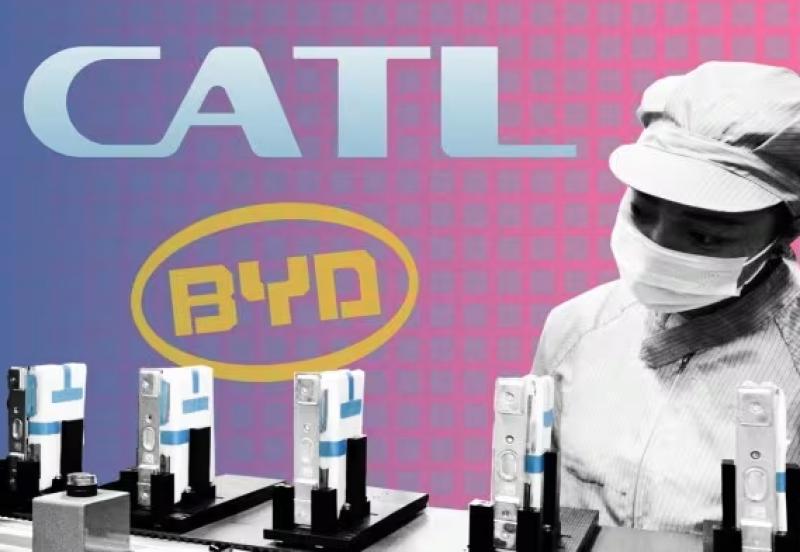A motor vehicle battery price war is kicking off
Category: Alternative Energy
Via: outis • last year • 12 commentsBy: Muhammad Rizwan Azhar, Edith Cowan University; Waqas Uzair, Edith Cowan University, and Yasir Arafat, Edith Cowan University


When comparing ICE (Internal Combustion Engine) cars with EVs, we usually forget that we're comparing a technology that has been constantly improving for well over a century, with another that is only a couple decades old.
We hear all sorts of things about EV batteries. Few are outright lies... but many are misleading, either intentionally or by ignorance. EV tech is a field where it's very easy to be ignorant, simply because it is evolving so fast.


Pools of brine containing lithium carbonate and mounds of salt bi-product stretch through a lithium mine in the Atacama Desert in Salar de Atacama, Chile.
John Moore/Getty Images
The main cost of an electric vehicle is its battery. The high cost of energy-dense batteries has meant EVs have long been more expensive than their fossil fuel equivalents.
But this could change faster than we thought. The world's largest maker of batteries for electric cars, China's CATL, claims it will slash the cost of its batteries by up to 50% this year, as a price war kicks off with the second largest maker in China, BYD subsidiary FinDreams.
What's behind this? After the electric vehicle industry experienced a huge surge in 2022, it has hit headwinds. It ramped up faster than demand, triggering efforts to cut costs.
But the promised price cuts are also a sign of progress. Researchers have made great strides in finding new battery chemistries. CATL and BYD now make EV batteries without any cobalt, an expensive, scarce metal linked to child labor and dangerous mining practices in the Democratic Republic of the Congo.
Economies of scale and new supplies of lithium make it possible to sell batteries more cheaply. And the world's largest carmaker, Toyota, is pinning its hopes on solid-state batteries in the hope these energy-dense, all but fireproof batteries will make possible EVs with a range of more than 1,200km per charge .
How are battery makers cutting costs?
The largest market for electric and plug-in hybrid vehicles is China. But demand for EVs here has eased off, dropping from a 96% surge in demand in 2022 to a 36% rise in 2023.
As a result, battery giant CATL has seen its profits fall for the first time in almost two years.
One of the best ways to create more demand is to make your products cheaper. That's what's behind the cost-cutting promises from CATL and BYD.
You might wonder how that's possible. One of the key challenges in shifting to battery-electric cars is where to get the raw materials. The electric future rests on viable supply chains for critical minerals such as lithium, nickel, copper, cobalt and rare earth elements.
Until recently, the main EV battery chemistry has been built on four of these, lithium, nickel, manganese and cobalt. These are also known as NMC batteries.
If you can avoid or minimise the use of expensive or controversial minerals, you can cut costs. That's why Chinese companies such as CATL have all but monopolised the market on another chemistry, lithium iron phosphate (LFP) batteries. These batteries are cheaper, as they have no cobalt. They have other benefits too: a longer usable life and less risk of fire than traditional lithium battery chemistries. The downside is they have lower capacity and voltage.
The recent price cuts come from a deliberate decision to use abundant earth materials such as iron and phosphorus wherever possible.
What about lithium? Prices of lithium carbonate, the salt form of the ultra light silvery-white metal, shot up sixfold between 2020 and 2022 in China before falling last year.
Despite this, battery prices have kept falling - just not by as much as they otherwise would have.
The world's huge demand for lithium has led to strong growth in supply, as miners scramble to find new sources. CATL, for instance, is spending A$2.1 billion on lithium extraction plants in Bolivia.
Growth in lithium supply is projected to outpace demand by 34% both this year and next, which should help stabilise battery prices.
Lithium production.
Skyhobo/Getty Images.
Battery options are multiplying
China's battery makers have cornered the market in lithium iron phosphate batteries. But they aren't the only game in town.
Tesla electric cars have long been powered by batteries from Japan's Panasonic and South Korea LG. These batteries are built on the older but well established NMC and lithium nickel cobalt aluminate oxide (NCA) chemistries. Even so, the American carmaker is now using CATL's LFP batteries in its more affordable cars.
The world's largest carmaker, Toyota, has long been sceptical of lithium-ion batteries and has focused on hybrid and hydrogen fuel cell vehicles instead.
But this is changing. Toyota is now focused heavily on making solid-state batteries a reality. These do away with liquid electrolytes to transport electricity in favour of a solid battery. In September last year, the company announced a breakthrough which it claims will enable faster recharging times and a range of 1,200km before recharge. If these claims are true, these batteries would effectively double the range of today's topline EVs.
In response, China's battery manufacturers and government are working to catch up with Toyota on solid-state batteries.
Which battery chemistry will win out? It's too early to say for electric vehicles. But as the green transition continues, it's likely we'll need not just one but many options.
After all, the energy needs of a prime mover truck will be different to city runabout EVs. And as electric aircraft go from dream to reality, these will need different batteries again. To get battery-electric aircraft off the ground, you need batteries with a huge power density.
The good news? These are engineering challenges which can be overcome. Just last year, CATL announced a pioneering "condensed matter" battery for electric aircraft, with up to three times the energy density of an average electric car battery.
All the while, researchers are pushing the envelope even further. A good electric car might have a battery with an energy density of 150-250 watt-hours per kilogram. But the record in the lab is now over 700 watt-hours/kg.
This is to say nothing of the research going into still other battery chemistries, from sodium-ion to iron-air to liquid metal batteries.
We are, in short, still at the beginning of the battery revolution.
Muhammad Rizwan Azhar, Lecturer, Edith Cowan University ; Waqas Uzair, Research associate, Edith Cowan University , and Yasir Arafat, Senior research associate, Edith Cowan University









Every week, there is news about new sources for materials, new methods for recovering and re-using materials, new technologies for using less exotic materials... EV batteries are a future gold mine for companies that get a good grip in the market early... like... NOW!
So, there's a lot of money being poured into improving battery tech. Whereas, ICE tech is on the beck burner.
There seems to be a story on a new source of material (s) every week. A few monthsago it was the Salton Sea in CA then somewhere in Utah then it was Norway and then Finland.
Currently, I'm checking my backyard for rare earth metals and also reading ''The Metaphysics of Modern Existence'' by Vine DeLoria JR. I have to debate myself and DeLoria's book to answer the age old question, what does an Indian think of the modern white world? My answer will have to do with what metals I find. I'm mercenary that way.
Rare earths are... not rare. The name dates from a time when their extraction was difficult.
So... you may actually find something.
Eureka, I did find something a roll of copper pennies.
And their extraction creates a lot of toxic waste.
”Geologically speaking, the rare earth elements are not especially rare. Deposits of these metals are found in many places around the globe, with some elements in about the same abundance in the earth’s crust as copper or tin. But rare earths are never found in very high concentrations and are usually found mixed together with one another or with radioactive elements, such as uranium and thorium.
The chemical properties of the rare earth elements make them difficult to separate from surrounding materials and from one another. These qualities also make them difficult to purify. Current production methods require a lot of ore and generate a great deal of harmful waste to extract just small amounts of rare earth metals. Waste from the processing methods include radioactive water, toxic fluorine, and acids.
https://www.sciencehistory.org/education/classroom-activities/role-playing-games/case-of-rare-earth-elements/history-future/#:~:text=The%20term%20rare%20earth%20was,could%20be%20dissolved%20in%20acid.
Is copper a rare earth ?
Rare Earth had some good songs for Motown, one of my favorites was:
I know I’m losing you
Or a LEO or pig?
That's why there's a lot of research into technologies that don't use rare earths. Apparently, there are many different combinations possible, each offering different performance characteristics.
EVs are just one use for batteries. Wind and solar being are not constant, so there's a need for batteries to level production. The tech here is wildly different, since constraints are wildly different. For example, one promising candidate uses molten salt.
It’ll be interesting to see where the tech is in 15-20 years. If somebody were to come up with a solution to hydrogen storage that would be the best option, very clean and very abundant. Another interesting new tech is electrofuel. The nice thing about that is the distribution infrastructure is already in place.
LOL